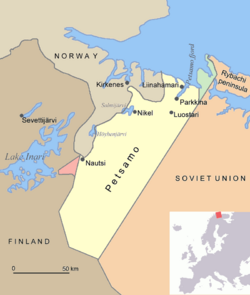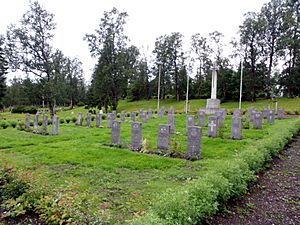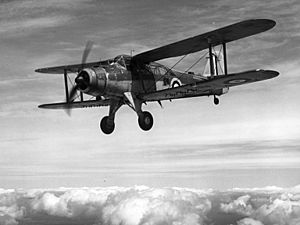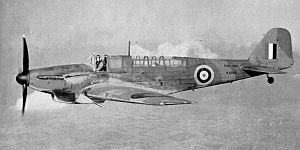Operation EF (1941) facts for kids
Quick facts for kids Operation EF (1941) |
|||||||
|---|---|---|---|---|---|---|---|
| Part of the Continuation War of the Second World War | |||||||
 Diagram showing Kirkenes and Petsamo (Parkkina) |
|||||||
|
|||||||
| Belligerents | |||||||
| Commanders and leaders | |||||||
| John Tovey Frederic Wake-Walker |
|||||||
| Strength | |||||||
| 29 Albacores and 9 Swordfish 15 Fulmars (escorts) 4 Hurricanes and 3 Fulmars (Fleet defence) 2 aircraft carriers 2 cruisers, 6 destroyers |
5 cargo vessels Luftwaffe fighters Anti-aircraft guns |
||||||
| Casualties and losses | |||||||
| 13 killed 25 captured 16 aircraft destroyed |
1 cargo ship sunk 1 cargo ship damaged 1 small steamer sunk 2 aircraft shot down several jetties destroyed |
||||||
Operation EF (1941), also known as the Raid on Kirkenes and Petsamo, was a military attack during the Second World War. It happened on July 30, 1941. British aircraft from the aircraft carriers HMS Victorious and Furious attacked German ships. These ships were in the ports of Kirkenes in northern Norway and Liinakhamari in Petsamo, Finland.
This attack took place after Germany invaded the Soviet Union in June 1941. The British wanted to stop supplies from reaching Germany and Finland in the Arctic. Admiral John Tovey, who led the British Home Fleet, thought the mission was too risky. He worried that the benefits would not be worth the dangers.
The British hoped to surprise the enemy. However, in the far north during summer, the sun never fully sets. This "midnight sun" made it hard to hide their ships and planes. German aircraft spotted the British force before the attack. This meant the surprise was lost.
The planes attacking Kirkenes faced many German fighter planes. They managed to sink one ship and damage another. But the British lost many aircraft. The planes attacking Petsamo faced less resistance. They caused only minor damage to docks and oil tanks. Overall, the operation was not successful for the British. Many planes were lost, and the results were small.
Contents
Why This Attack Happened
The War in the Arctic
The attack was part of the Continuation War, which was a conflict between Finland and the Soviet Union. It was also linked to Operation Barbarossa, Germany's invasion of the Soviet Union.
In 1940, Germany and Finland made a deal. German air force (Luftwaffe) planes could travel through Finland to Kirkenes in northern Norway. This helped Germany move troops and supplies.
Germany wanted to cut off Murmansk, a key Soviet city and port. Murmansk was important for supplies. They also wanted to protect iron mines in Sweden and nickel mines near Pechenga. Kirkenes was a German air base close to these areas.
In early 1941, Germany planned its attack on the Soviet Union. They wanted to defend northern Norway first. German mountain troops were sent to Finland to protect Pechenga. This was part of a plan called Operation Rentier. The German invasion of the Soviet Union began on June 22, 1941. Later, Germany launched attacks like Operation Platinum Fox and Operation Silver Fox in the Arctic.
Getting Ready for the Attack
German submarines and destroyers moved to the Arctic waters near Kirkenes. Before Germany invaded the Soviet Union, the British Home Fleet mainly watched the North Sea. But after June 1941, their focus shifted north to the Arctic.
The Soviet Union asked Britain to attack German and Finnish ships in the Arctic. Both Britain and the United States knew how important Murmansk was for getting war supplies. The British Navy leaders pushed Admiral John Tovey to use his aircraft carriers, HMS Furious and Victorious.
Admiral Tovey was worried. He knew it was risky to use carriers so close to German airfields. Also, the "midnight sun" in northern Norway meant it was bright all night. This made surprise attacks very difficult. But the Navy leaders told Tovey to go ahead with Operation EF.
Force P: The British Attack Group
The aircraft carrier Furious carried Fairey Fulmar fighter planes and Sea Hurricanes. It also had Fairey Swordfish and Fairey Albacore torpedo planes. The carrier Victorious had more Albacore planes and Fulmar fighters.
Rear-Admiral Frederic Wake-Walker led Force P. This group included the two aircraft carriers, two cruisers (HMS Devonshire and HMS Suffolk), and six destroyers. They left Scapa Flow, Scotland, on July 23. They refueled in Iceland and then sailed towards Norway. Two destroyers had to return after hitting a British mine.
The British did not expect much resistance from the German air force (Luftwaffe). They thought their Fulmar fighters would be enough to protect the attack. The planes from Victorious were told to attack Kirkenes. Those from Furious were to attack Petsamo. If there were no ships, they would attack factories or oil tanks.
On July 29, Force P reached its position near Kirkenes. The weather became clear, making it harder to hide. Just before the planes took off, a German He 111 aircraft was seen. This meant the British had lost their chance for a surprise attack.
The Attack Begins
Fighting at Kirkenes
Victorious sent 20 Albacore planes and 9 Fulmar fighters. They flew low to avoid radar. But they flew over a German hospital ship, which meant they were definitely spotted. As they flew over the mountains, they faced heavy anti-aircraft fire.
Suddenly, the ground fire stopped. Then, 13 German Messerschmitt Bf 109 and Bf 110 fighters appeared. They were escorting 9 Junkers Ju 87 (Stuka) dive-bombers.
The British pilots found only a few ships in the harbor. These included a German training ship and two cargo ships. The Albacores attacked these ships. The Fulmar fighters tried to keep the German fighters away from the Albacores. They shot down one German Bf 110. But two British Fulmars were also shot down.
The Albacores quickly dropped their torpedoes to escape the anti-aircraft fire. They sank one 2,000-ton ship and set another on fire. They also caused minor damage on shore. The Albacores tried to get away from the German fighters. But 11 of them were shot down by anti-aircraft fire and German planes. One British pilot claimed to have shot down a German Ju 87. German records later confirmed the loss of at least one Bf 110 and one Ju 87.
Raid on Petsamo
Furious sent 9 Swordfish and 9 Albacore planes to attack Petsamo. One Fulmar plane was lost before the attack due to engine trouble. The pilots found the harbor almost empty, except for anti-aircraft guns.
The planes dropped their torpedoes against a small ship and the wooden docks. But these docks were easily replaced. British Fulmar bombers attacked a shipyard and oil tanks, but caused little damage. German Bf 109 fighters then attacked the British planes. One Albacore and one Fulmar were shot down.
What Happened Next
Losses from the Attack

The attack was very costly for the British. Many planes were lost, and many airmen were killed or captured. In 2005, one report said that 12 Albacores and 4 Fulmars were lost. Nine men were killed, and 27 were taken prisoner. Two airmen were rescued by Soviet forces after two days at sea. Other reports state that 16 aircraft were lost in total.
Later Operations
After the raid, the Albacore squadrons on Victorious were replaced. Victorious then joined Force M, which operated near Bear Island and the White Sea. This force was part of Operation Dervish, which helped deliver supplies to the Soviet Union.
On September 3, the British tried to attack ships sailing from Tromsø to Kirkenes. But the attack was called off when the clouds cleared. This was because of the risk of German fighter planes. Force M stayed off the Norwegian coast. On September 12, they attacked ships and shore buildings at Bodø. They sank one ship and damaged an aluminum factory.
The British planned a second raid because there was little fighter opposition. But this raid was canceled when a German He 111 bomber spotted the British force. Two British Grumman Martlet fighters chased and shot down the German bomber.
Later, two German Blohm & Voss BV 138 flying boats started following the British force. The British Fulmar fighters found it hard to damage them because of their strong armor. On October 9, a raid was difficult due to rough seas. Five of 13 Albacore planes on deck were damaged. Three Albacores managed to find and attack a cargo ship. Later that day, other British planes attacked two merchant ships and damaged them.



